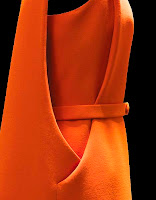Super gazar, guipure, shantung, ottoman, cloqué, taffeta, georgette crepe, chenille- velvet, cigalina, lurex, lacquered craknyl, “sculpted lamé”, “lizard satin”…playful names to describe equally playful fabrics and textures. All the same I don’t think that Cristóbal Balenciaga would describe his métier as playful. His extreme devotion to his art was very serious.
CRISTOBAL BALENCIAGA, the couturier who did
it all. According to his friend Coco Chanel he was the only one of his cadre
that was able to devise, cut, assemble and sew a garment. Born in Guetaria, in
the Basque Country, in 1895, he first learned from his mother, and then from
the selective clientele that gave him a chance to further develop his skills.
After years of working hard for others, he opened his first atelier in San
Sebastián. After a few other successful entrepreneurial initiatives he
relocated to Paris, a move coinciding with the outbreak of the Spanish Civil
War. The 50s and 60s were the years of exuberant experimentation that brought him
international acclaim. He invented the tunique suit, the sack shape and the
baby doll line. His evolving esthetic pushed the boundaries of minimalism
until, according to Metropolitan Museum curator Harold Koda, “there was no more
to cut”. He experimented with fabrics and style as would a sculptor, to the
point that he lost sight of his garments’ intentions -his museum in Guetaria displays a fantastic
cloak with no slits for the arms- but he was an artist after all, wasn’t he?
One can find endless praises of The Master
from colleagues, friends and employees. His name is mentioned in countless
fashion sources and student dissertations.
Strangely enough, his personal life, and personality for that matter,
are a near-complete mystery. Balenciaga’s
only press interview was given to The
Times, in August of 1971, to the fashion editor Prudence Glynn, and only
after he had closed his atelier (he died one year later). For me that mystery
is the most intriguing part of his story. Was he too engrossed in his job to
bother with a little PR? Maybe too much of a perfectionist, easily irritated by
the fallacies of his fellow human beings?
Was his distance a product of snobbery, of feeling part of an
unreachable elite? How did he live, did his aristocratic clientele make him
rich? Who was the “close person”, who’s death made him almost close down his
business in 1948? He has been described as very religious. Was he homosexual?
Did he find in Paris the freedom that eluded him in provincial Spain? Why did
he break his business partnership with the Lizaso sisters with whom he had
opened up his first atelier in San Sebastián? Did his zeal to keep away the
press at the presentation of his collections seem eccentric at the time? What
role did Wladio d’Attainville, his long time collaborator, play in his life?
What did he like to do when he wasn’t working? Was he soaking in the
Mediterranean sun as any old tourist might when death surprised him in Jávea,
Alicante?
I probably need to start thinking of a part
II for this post, there are just too many questions for such a formidable
personality.
Why is his museum so hard to find, and why
did they choose the smallest sign available to christen it. Why Guetaria, has not become a don’t-miss destination for pilgrims seeking to
commune with The Master and another historic figure, the great explorer Juan Sebastián Elcano, is material for another post entitled “Spaniards and their
hopeless marketing mentality”. Just imagine the boom in hotel occupancy if both
of those personalities had been French or British…no wonder we’re economically
doomed!









El dedo en la llaga Cayetana. Please write more about Balenciaga! Nx
ReplyDelete